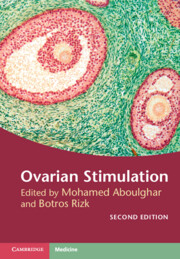Book contents
- Ovarian Stimulation
- Ovarian Stimulation
- Copyright page
- Dedication
- Contents
- Contributors
- About the Editors
- Foreword
- Preface to the first edition
- Preface to the second edition
- Section 1 Mild Forms of Ovarian Stimulation
- Section 2 Ovarian Hyperstimulation for IVF
- Section 3 Difficulties and Complications of Ovarian Stimulation and Implantation
- Section 4 Non-conventional Forms Used during Ovarian Stimulation
- Chapter 20 Adjuncts for Ovarian Stimulation
- Chapter 21 Luteinizing Hormone Supplementation during Ovarian Stimulation
- Chapter 22 Ovulation Induction for Hypogonadotropic Hypogonadism
- Section 5 Alternatives to Ovarian Hyperstimulation and Delayed Transfer
- Section 6 Procedures before, during, and after Ovarian Stimulation
- Index
- References
Chapter 21 - Luteinizing Hormone Supplementation during Ovarian Stimulation
from Section 4 - Non-conventional Forms Used during Ovarian Stimulation
Published online by Cambridge University Press: 14 April 2022
- Ovarian Stimulation
- Ovarian Stimulation
- Copyright page
- Dedication
- Contents
- Contributors
- About the Editors
- Foreword
- Preface to the first edition
- Preface to the second edition
- Section 1 Mild Forms of Ovarian Stimulation
- Section 2 Ovarian Hyperstimulation for IVF
- Section 3 Difficulties and Complications of Ovarian Stimulation and Implantation
- Section 4 Non-conventional Forms Used during Ovarian Stimulation
- Chapter 20 Adjuncts for Ovarian Stimulation
- Chapter 21 Luteinizing Hormone Supplementation during Ovarian Stimulation
- Chapter 22 Ovulation Induction for Hypogonadotropic Hypogonadism
- Section 5 Alternatives to Ovarian Hyperstimulation and Delayed Transfer
- Section 6 Procedures before, during, and after Ovarian Stimulation
- Index
- References
Summary
Folliculogenesis in humans is a long process. It has become clear that there are two main time points in follicular development, the “initial recruitment” that takes place at the stage of primordial follicles and the “cyclic recruitment” at the stage of small antral follicles [1]. In humans, the initial recruitment is gonadotropin independent, while cyclic recruitment is entirely dependent on the action of both follicle-stimulating hormone (FSH) and luteinizing hormone (LH) [2]. Locally produced substances affect the action of gonadotrophins on follicle maturation. The balanced effect of FSH and LH in the normal menstrual cycle ensures the selection of a single follicle.
- Type
- Chapter
- Information
- Ovarian Stimulation , pp. 199 - 207Publisher: Cambridge University PressPrint publication year: 2022



